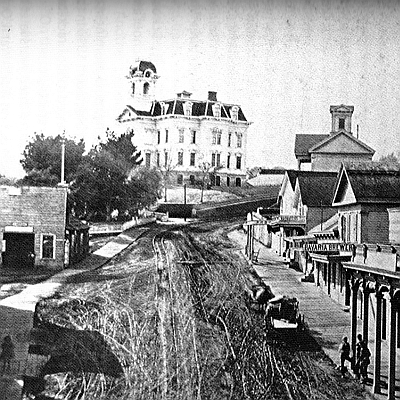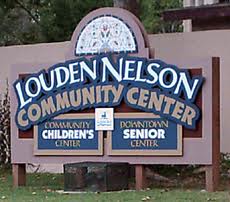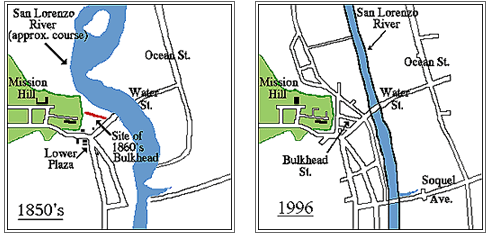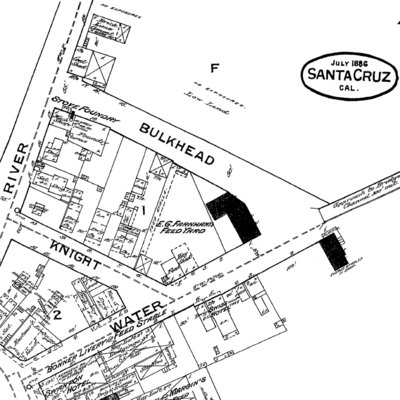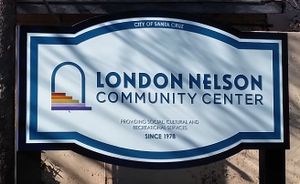History Pages: 21 - The River
For a table of contents, see History pages.
As noted previously, the Civil War years were not especially active ones in Santa Cruz, other than the founding of the Santa Cruz Powder Works and the San Lorenzo Paper Mill. There were, however, some notable local events not related to the war. We’ve heard it said that the only certainties are death and taxes. In the 1860s, taxes were not yet much of a concern in Santa Cruz, but death comes for us all. There was another certainty, if you lived near the San Lorenzo River - floods.
The death I want to remember is that of ex-slave Loudon (or London - see note 1) Nelson, who died in Santa Cruz in 1860. Nelson, who had lived in town since 1853, was apparently well-known and liked. He got a nice obituary in the Weekly Sentinel and is buried at Evergreen Cemetery. His passing was also important to the town’s future - he willed his downtown property to the school district, to support public schools in Santa Cruz. The land was sold, and the proceeds were later used to buy a lot adjacent to the Mission Hill School. The added lot became part of the schoolyard when the original 1857 school building was replaced with a larger one in 1875.
A memorial to Nelson now stands at the top of the old schoolyard steps off Mission Street. In this photo (c.1875-1893) looking up Mission Street toward the 1875 school, you can see those steps. Besides Mission Street itself, the steps are the only thing in that photo that still exists today. The steps lead to a nice but little-used public path through what used to be the schoolyard.
Most of us are more familiar with Nelson’s name because of the Community Center (photo right - see below for the 2022 sign). The former Laurel School was converted to its current use in 1978, and renamed to honor Nelson.
The property Nelson left to the school district was on Water Street, near the ford that was one of the only ways to cross the river at that time (Another ford was farther downstream at the Branciforte Creek confluence).
In the winter of 1862, Nelson's former land was underwater when one of the worst floods of the century struck Santa Cruz. A major contributing factor was the winding course of the river at that time.
Follow the link to the article "The History of Floods on the San Lorenzo River in the City of Santa Cruz", by Daniel McMahon, on the SCPL website and take a look at the two maps shown at right. Before reading that article, I was dismissive of the name River Street as lacking imagination. Looking at that 1862 map, however, made me realize that today’s River Street is not so-named just because it’s next to the San Lorenzo River. Back in those days, it was the river, with a big bend running right under the Mission Hill bluff below the end of School Street. Remember also that, unlike more recent floods, there were no bridges in 1862 to get clogged up with debris and cause flooding to begin at the bridge. So, like a car on a wet highway, when the rain-swollen river tried to move too fast it couldn’t take that sharp bend and jumped the bank. The flooding was not limited to the Santa Cruz flats, either. The brand-new San Lorenzo Paper Mill (~3 miles upstream, its site now part of Paradise Park) was completely destroyed by the raging river and had to be rebuilt almost from scratch.
If you're curious about the big San Lorenzo River island shown on the "1850's" map, take a look at the 1866 photograph in History Pages: 13 - The County. Just above and beyond the roof of Holy Cross church, you can see the big bend in the river - and the island.
The section of riverbank where the river overflowed in 1862 is today's Bulkhead Street. After the 1862 flood, lowlands developer Elihu Anthony built a sturdy wall (bulkhead) parallel to and near the riverbank, hoping to divert future floodwaters around his property. Soon after, increasing prosperity allowed Anthony to build a new home up on the bluff, safe from future floodwaters.
As late as 1886, the north side of Bulkhead Street was shown on a Sanborn Fire Insurance Co. map (left) as empty “Low Land”. Anthony’s bulkhead probably functioned as a retaining wall to form the north edge of the street, allowing the area to the south of it to be filled and raised. When today’s levees were built in the late 1950s to finally contain the course of the river, downtown Santa Cruz gained a lot of real estate - much of it along River Street and now safe from flooding. Nelson's former land was to the southeast of Water Street, in or near some of the riverside "low land". Nelson died in 1860, before either the bulkhead or the first bridge were built.
Notes
1. On June 8, 2021, the Santa Cruz City Council passed a resolution declaring that the man's correct name was London Nelson, officially changing the spelling of the name wherever it appears on city property (notably the Community Center). As of December 2022, the monument above the former Mission Hill School steps has also been changed (don't know exactly when it happened).
